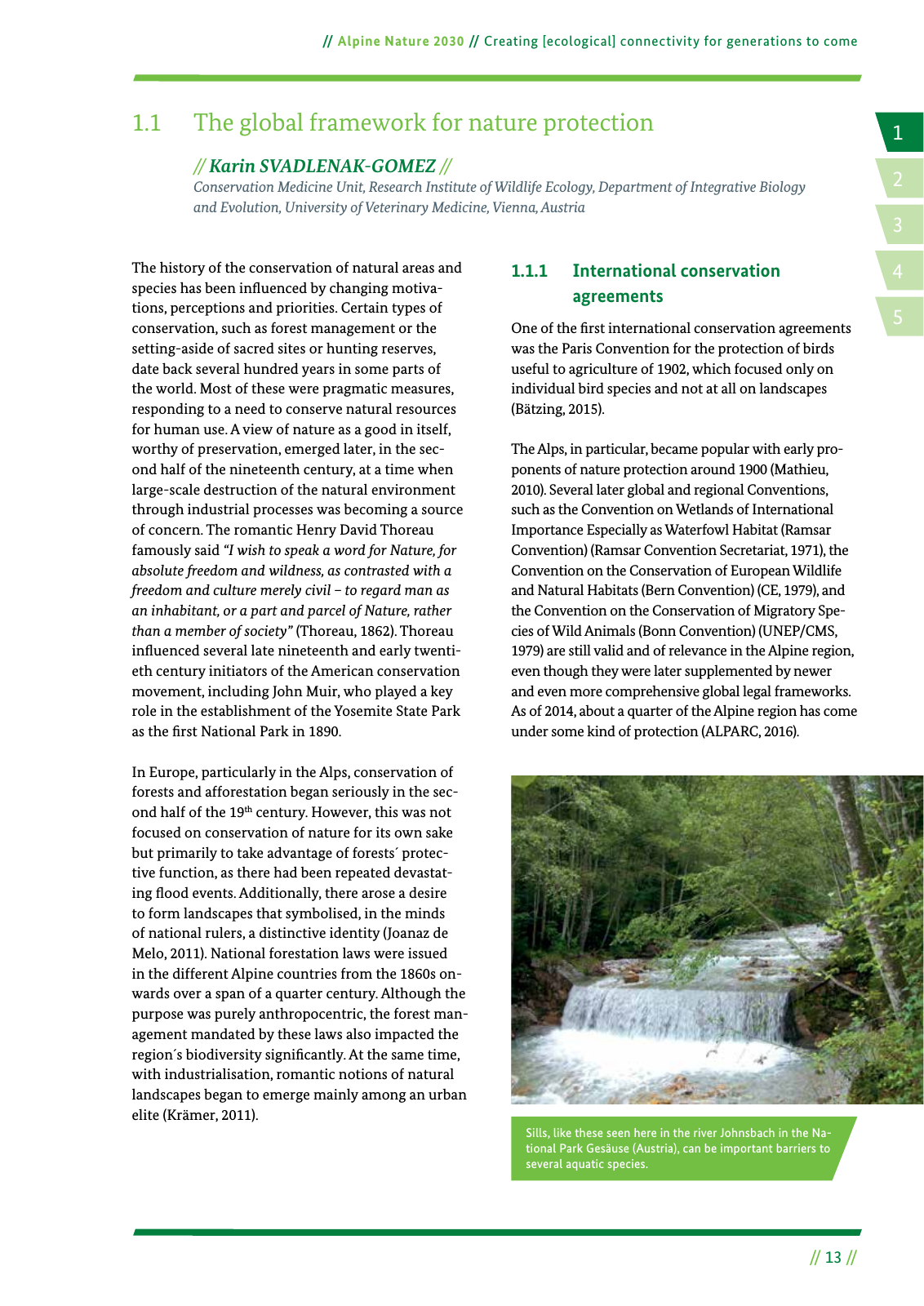14 2 5 3 13 Alpine Nature 2030 Creating ecological connectivity for generations to come Sills like these seen here in the river Johnsbach in the Na tional Park Gesäuse Austria can be important barriers to several aquatic species 1 1 The global framework for nature protection Karin SVADLENAK GOMEZ Conservation Medicine Unit Research Institute of Wildlife Ecology Department of Integrative Biology and Evolution University of Veterinary Medicine Vienna Austria The history of the conservation of natural areas and species has been in uenced by changing motiva tions perceptions and priorities Certain types of conservation such as forest management or the setting aside of sacred sites or hunting reserves date back several hundred years in some parts of the world Most of these were pragmatic measures responding to a need to conserve natural resources for human use A view of nature as a good in itself worthy of preservation emerged later in the sec ond half of the nineteenth century at a time when large scale destruction of the natural environment through industrial processes was becoming a source of concern The romantic Henry David Thoreau famously said I wish to speak a word for Nature for absolute freedom and wildness as contrasted with a freedom and culture merely civil to regard man as an inhabitant or a part and parcel of Nature rather than a member of society Thoreau 1862 Thoreau in uenced several late nineteenth and early twenti eth century initiators of the American conservation movement including John Muir who played a key role in the establishment of the Yosemite State Park as the rst National Park in 1890 In Europe particularly in the Alps conservation of forests and afforestation began seriously in the sec ond half of the 19th century However this was not focused on conservation of nature for its own sake but primarily to take advantage of forests protec tive function as there had been repeated devastat ing ood events Additionally there arose a desire to form landscapes that symbolised in the minds of national rulers a distinctive identity Joanaz de Melo 2011 National forestation laws were issued in the different Alpine countries from the 1860s on wards over a span of a quarter century Although the purpose was purely anthropocentric the forest man agement mandated by these laws also impacted the region s biodiversity signi cantly At the same time with industrialisation romantic notions of natural landscapes began to emerge mainly among an urban elite Krämer 2011 1 1 1 International conservation agreements One of the rst international conservation agreements was the Paris Convention for the protection of birds useful to agriculture of 1902 which focused only on individual bird species and not at all on landscapes Bätzing 2015 The Alps in particular became popular with early pro ponents of nature protection around 1900 Mathieu 2010 Several later global and regional Conventions such as the Convention on Wetlands of International Importance Especially as Waterfowl Habitat Ramsar Convention Ramsar Convention Secretariat 1971 the Convention on the Conservation of European Wildlife and Natural Habitats Bern Convention CE 1979 and the Convention on the Conservation of Migratory Spe cies of Wild Animals Bonn Convention UNEP CMS 1979 are still valid and of relevance in the Alpine region even though they were later supplemented by newer and even more comprehensive global legal frameworks As of 2014 about a quarter of the Alpine region has come under some kind of protection ALPARC 2016

Hinweis: Dies ist eine maschinenlesbare No-Flash Ansicht.
Klicken Sie hier um zur Online-Version zu gelangen.
Klicken Sie hier um zur Online-Version zu gelangen.